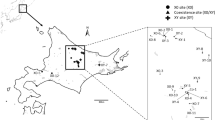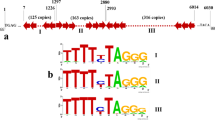Abstract
The genera Nothoscordum and Ipheion (Allioideae, Amaryllidaceae) are cytologically characterized by a dysploid series with variable numbers of metacentric and acrocentric chromosomes typical of karyotypes rearranged by Robertsonian translocations (RT). Since they have large chromosomes, low diploid numbers, and possess two telomeric motifs [the vertebrate-type (TTAGGG) n and the Arabidopsis-type (TTTAGGG) n ] they are suitable for investigating the occurrence and possible role of interstitial telomeric sites (ITS) associated with RT. We analyzed the distributions of telomeric sites in 12 species of Nothoscordum and Ipheion and found that both telomeric probes colocalized in all chromosome termini. Cloning and sequencing PCR products obtained using both telomeric primers simultaneously revealed long stretches of (TTAGGG) n and (TTTAGGG) n sequences together with degenerated telomeric sequences. Most acrocentric chromosomes have a 45S rDNA site at the terminal region of the short arms adjacent to the most distal telomeric sites. Telomeric signals were found at all chromosome ends, but ITS were also detected in a few proximal and subterminal regions in some Nothoscordum species. Although RT are common in this group of plants, our findings suggest that proximal positioning of telomeric motifs are not necessarily related to that kind of rearrangement. Rather, transposition of telomeric sequences followed by amplification, could better explain the presence of (TTAGGG) n and (TTTAGGG) n repeats at those sites. Furthermore, a few small interstitial sites found in some Nothoscordum species indicate that dispersion of these sequences was not restricted to the proximal region.





Similar content being viewed by others

References
Adams SP, Hartman TPV, Lim KY, Chase MW, Bennett MD, Leitch IJ, Leitch AR (2001) Loss and recovery of Arabidopsis-type telomere repeat sequences 5′-(TTAGGG) n -3′ in the evolution of a major radiation of flowering plants. Proc R Soc Lond 268:1541–1546
Azzalin CM, Nergadze SG, Giulotto E (2001) Human intrachromosomal telomeric-like repeats: sequence organization and mechanisms of origin. Chromosoma 110:75–82
Cazaux B, Catalan J, Veyrunes F, Douzery EJP, Britton-Davidian J (2011) Are ribosomal DNA clusters rearrangement hotspots? A case study in the genus Mus (Rodentia, Muridae). BMC Evol Biol 11:124
Cox AV, Bennett ST, Parokonny AS, Kenton A, Callimassia MA, Bennett MD (1993) Comparison of plant telomere locations using a PCR-generated synthetic probe. Ann Bot 72:239–247
Crosa O (1972) Estudios cariología en el género Nothoscordum (Liliaceae). Bol Fac Agron Uruguay 122:3–8
da Silva CR, González-Elizondo MS, Vanzela AL (2005) Reduction of chromosome number in Eleocharis subarticulata (Cyperaceae) by multiple translocations. Bot J Linn Soc 149:457–464
Fuchs J, Brandes A, Schubert I (1995) Telomere sequence localization and karyotype evolution in higher-plants. Plant Syst Evol 196:227–241
Guerra M (2008) Chromosome numbers in plant cytotaxonomy: concepts and implications. Cytogenet Genome Res 120:339–350
Guerra M, Felix LP (2000) O cariótipo de Nothoscordum pulchellum (Alliaceae) com ênfase na heterocromatina e sítios de DNAr. Bol Soc Argent Bot 35:283–289
He L, Liu J, Torres GA, Zhang H, Jiang J, Xie C (2012) Interstitial telomeric repeats are enriched in the centromeres of chromosomes in Solanum species. Chromosome Res 21:5–13
Ijdo JW, Wells RA, Baldini A, Reeders ST (1991) Improved telomere detection using a telomere repeat probe (TTAGGG)n generated by PCR. Nucleic Acids Res 13:17
Jarmuz-Szymczak M, Janiszewska J, Szyfter K, Shaffer LG (2014) Narrowing the localization of the region breakpoint in most frequent Robertsonian translocations. Chromosome Res 22:517–532
Jiang J, Gill BS (2006) Current status and the future of fluorescence in situ hybridization (FISH) in plant genome research. Genome 49:1057–1068
Jones K (1998) Robertsonian fusion and centric fission in karyotype evolution of higher plants. Bot Rev 64:273–289
Kearse M, Moir R, WilsonA Stones-Havas S, Cheung M, Sturrock S, Buxton S, Cooper A, Markowitz S, Duran C, Thierer T, Ashton B, Mentijes P, Drummond A (2012) Geneious Basic: an integrated and extendable desktop software platform for the organization and analysis of sequence data. Bioinformatics 28:1647–1649
Kupiec M (2014) Biology of telomeres: lessons from budding yeast. FEMS Microbiol Rev 38:144–171
Lin KW, Yan J (2008) Endings in the middle: current knowledge of interstitial telomeric sequences. Mutat Res Rev Mutat 658:95–110
Meyne J, Baker RJ, Hobart HH, Hsu TC, Ryder OA, Ward OG, Wiley JE, Wurster-Hill DH, Yates TL, Moyzis RK (1990) Distribution of non-telomeric sites of the (TTAGGG)n telomeric sequence in vertebrate chromosomes. Chromosoma 99:3–10
Mizuno H, Wu J, Kanamori H, Fujisawa M, Namiki N, SajiS Katagiri S, Katayose Y, Sasak T, Matsumoto T (2006) Sequencing and characterization of telomere and subtelomere regions on rice chromosomes 1S, 2S, 2L, 6L, 7S, 7L and 8S. Plant J 46:206–217
Ocalewicz K (2012) Genomic distribution of telomeric DNA sequences—What do we learn from fish about telomere evolution? In: Reviews on Selected topics of telomere biology. Intech Open Access Publisher pp 271–294
Pich U, Fuchs J, Schubert I (1996) How do Alliaceae stabilize their chromosome ends in the absence of TTTAGGG sequences? Chromosome Res 4:207–213
Raskina O, Barber JC, Nevo E, Belyayev A (2008) Repetitive DNA and chromosomal rearrangements: speciation-related events in plant genomes. Cytogenet Genome Res 120:351–357
Richards EJ, Ausubel FM (1988) Isolation of a higher eukaryote telomere from Arabidopsis thaliana. Cell 53:127–136
Roa F, Guerra M (2012) Distribution of 45S rDNA sites in chromosomes of plants: structural and evolutionary implications. BMC Evol Biol 12:225
Ruiz-Herrera A, Robinson TJ (2008) Evolutionary plasticity and cancer breakpoints in human chromosome 3. Bio Essays 30:1126–1137
Scacchetti PC, Utsunomia R, Pansonato-Alves JC, da Costa-Silva GJ, Oliveira C, Foresti F (2015) Extensive spreading of interstitial telomeric sites on the chromosomes of Characidium (Teleostei, Characiformes). Genetica 143:263–270
Schubert I, Schriever-Schwemmer C, Werner T, Adler ID (1992) Telomeric signals in Robertsonian fusion and fission chromosomes: implications for the origins of pseudoaneuploidy. Cytogenet Genome Res 59:6–9
Schweizer D, Loidl J (1987) A model for heterochromatin dispersion and the evolution of C-band patterns. Chromosome Today 9:61–74
Souza LGR, Crosa O, Winge H, Guerra M (2009) The karyotype of Nothoscordum arenarium Herter (Gilliesioideae, Alliaceae): a populational and cytomolecular analysis. Genet Mol Biol 32:111–116
Souza LGR, Crosa O, Guerra M (2010) Karyological circumscription of Ipheion Rafinesque (Gilliesioideae, Alliaceae). Plant Syst Evol 287:119–127
Souza LGR, Crosa O, Speranza P, Guerra M (2012) Cytogenetic and molecular evidence suggest multiple origins and geographical parthenogenesis in Nothoscordum gracile (Alliaceae). Ann Bot 109:987–999
Souza G, Crosa O, Guerra M (2015) Karyological, morphological, and phylogenetic diversification in Leucocoryne Lindl (Allioideae, Amaryllidaceae). Plant Syst Evol 301:2013–2023
Sýkorová E, Lim KY, Fajkus J, Leitch AR (2003a) The signature of the Cestrum genome suggests an evolutionary response to the loss of (TTTAGGG)n telomeres. Chromosoma 112:164–172
Sýkorová E, Lim KY, Kunická Z, Chase MW, Bennett MD, Fajkus J, Leitch AR (2003b) Telomere variability in the monocotiledoneous plant order Asparagales. Proc R Soc Lond B 270:1893–1904
Sýkorová E, Fajkus J, Mezníková M, Lim KY, Neplechová K, Blattner FR, Chase MW, Leitch AR (2006) Minisatelite telomeres occur in the family Alliaceae but are lost in Allium. Am J Bot 93:814–823
Weiss-Schneeweiss H, Riha K, Jang CG, Puizina J, Scherthan H, Schweizer D (2004) Chromosome termini of the monocot plant Othocallis siberica are maintained by telomerase, which specifically synthesises vertebrate-type telomere sequences. Plant J 37:484–493
Acknowledgments
The authors wish to thank the Brazilian agencies Conselho Nacional de Desenvolvimento Científico e Tecnológico (CNPq), Fundação de Amparo à Ciência e Tecnologia de Pernambuco (FACEPE - APQ-2008-2.02/12) for financial support and a grant to G.S. by Coordenação de Aperfeiçoamento de Pessoal de Nível Superior (CAPES).
Author information
Authors and Affiliations
Corresponding author
Electronic supplementary material
Below is the link to the electronic supplementary material.
10709_2016_9886_MOESM1_ESM.tif
Appendix S1 Analysis of 5 s rDNA-like fragment of Nothoscordum gracile clone pNg-tel3. Phylogenetic comparison and identity with part of the 5S rDNA gene of several angiosperms. As outgroups two species of gymnosperms (Pinus and Cycas) (TIFF 19615 kb)
Rights and permissions
About this article
Cite this article
Souza, G., Vanzela, A.L.L., Crosa, O. et al. Interstitial telomeric sites and Robertsonian translocations in species of Ipheion and Nothoscordum (Amaryllidaceae). Genetica 144, 157–166 (2016). https://doi.org/10.1007/s10709-016-9886-1
Received:
Accepted:
Published:
Issue Date:
DOI: https://doi.org/10.1007/s10709-016-9886-1



